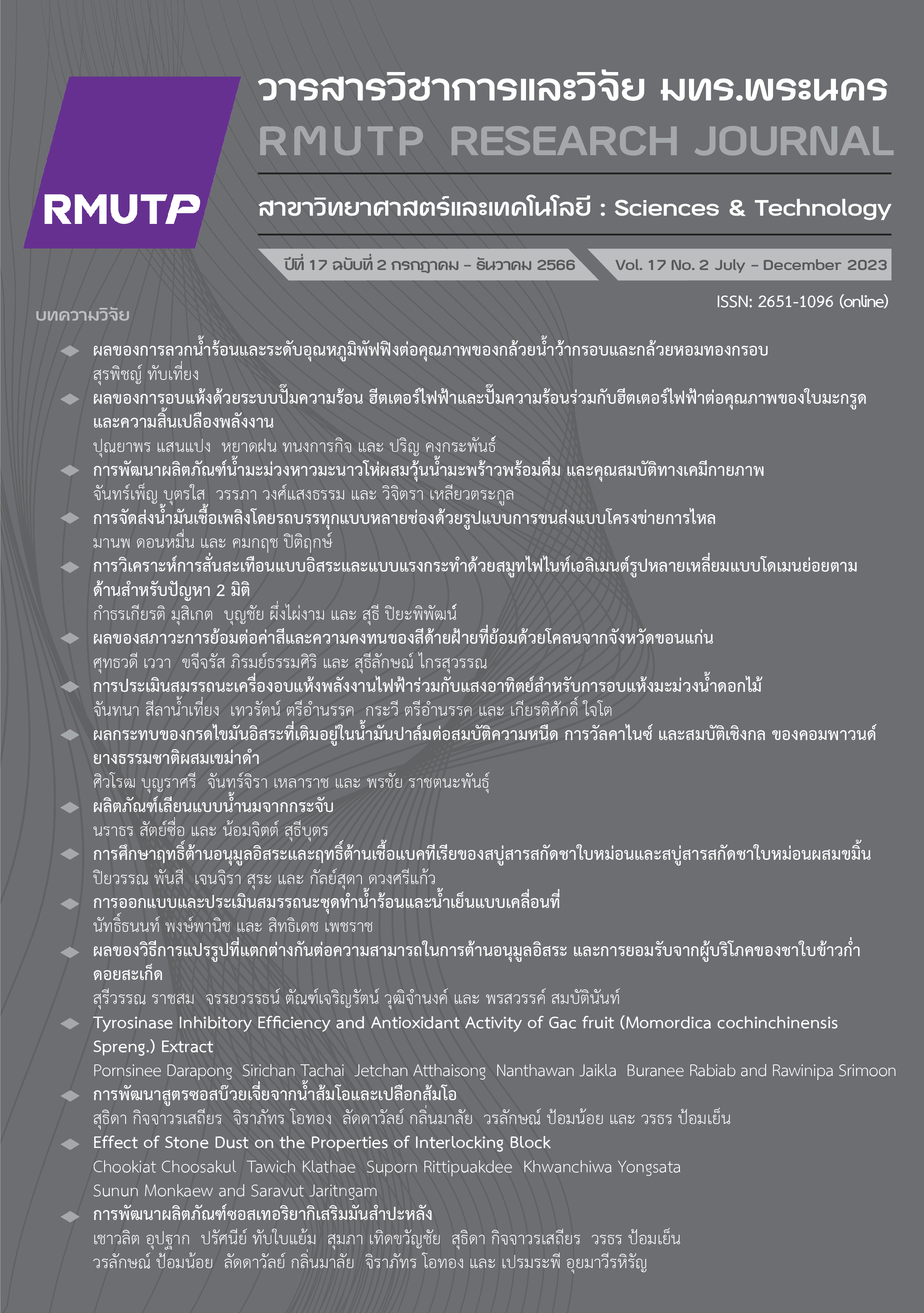Study on Antioxidant and Antibacterial Activity of Mulberry Leaf Tea Extract Soap and Mulberry Leaf Tea Extract Mixed with Turmeric Soap
Main Article Content
Abstract
The objective of this research was to develop glycerin soap products, mulberry leaf tea extract and mulberry leaf tea extract mixed with turmeric soaps, containing herbs of Lopburi province. The physical and other chemical properties of soaps, antioxidant activity tested using DPPH method, and antibacterial activity were studied. Six soap formulations, each of which contained 25 g glycerin soap base, were compared. Three soaps contained varied amount of 10 g/100 mL mulberry tea extract while the others were turmeric powder soap, mulberry tea extract and turmeric powder soap, and the non-herbal soap (control). From the results of the experiment, it was found that the soap had no foreign matter. The color values expressed as L*, a* and b* of the soaps containing mulberry extract were 14.07 ± 1.44 to 19.47 ± 0.14, -0.05 ± 0.14 to 0.80 ± 0.12, and 2.13 ± 0.08 to 3.25 ± 0.40, respectively, while those values of the soap containing turmeric powder were 20.06 ± 1.01, 4.98 ± 0.29, and 6.52 ± 0.26, respectively. The properties of all soaps; pH (9.36 – 9.83), bubble volume (66.33 to 76.67 mL), durability of the bubble (62.33 - 70.67 mL), and erosion percentage (23.09 ± 2.15 to 25.08 ± 1.23 %), were evaluated. The antioxidant activity values of the soaps were in the range of 18.38 ± 0.93 to 53.36 ± 0.39 %, and also expressed as 1.25 ± 0.01 to 3.45 ± 0.11 ascorbic acid equivalents (AAE)/g soap. The herbal-containing soaps had higher antioxidant activity than the non-herbal soap. The soap could inhibit gram-positive bacteria; Bacillus cereus and Staphylococcus aureus.
Article Details

This work is licensed under a Creative Commons Attribution-NonCommercial-NoDerivatives 4.0 International License.
ลิขสิทธ์ ของมหาวิทยาลัยเทคโนโลยีราชมงคลพระนครReferences
M. R. Chirani, E. Kowsari, T. Teymourian and S. Ramakrishna, “Environmental impact of increased soap consumption during COVID-19 pandemic: Biodegradable soap production and sustainable packaging”, Science of the Total Environment, vol. 796, no. 149013, pp. 1-11, 2021.
J. Siriboriruk and S. Prueksaritanond, “COVID-19,” BJM, vol. 7, no. 1, pp. 89–95, Jan. – Jun. 2020.
N. Chaitiang, “Preventive measures for newly emerging COVID 19 infection,” Public Health Policy & Law Journal, vol.7, no. 3, pp. 541-553, Sep. - Dec. 2021.
N. Chamchoi, A. Bulsathaporn and C. Bunyagidj, “COVID-19: Prevention under Environmental Health Perspective” Journal of Health Science, vol. 30, pp. 376–388, Jul. – Aug. 2021.
N. Methaakkharadecha and A. Srisopa, “Phenolic contents and antioxidant activities of mulberry leaf tea and water soluble mulberry leaf tea powder,” Thai Journal of Science and Technology, vol. 9, no. 2, pp. 230-242, Mar. – Apr. 2020.
C. Thongkham, T. Techakriengkrai, R. Kongkachuichai, and R. Charoensiri, “Antioxidant activities and polyphenol compounds in snack products fortified with mulberry leaf powder,” RMUTP Research Journal, vol. 4, no. 2, pp. 57-71, Jul.-Dec. 2020.
X. He, J. Fang, Y. Ruan, X. Wang, Y. Sun, N. Wu, Z. Zhao, Y. Chang, N. Ning, H. Guo, and L. Huang, “Structures, bioactivities and future prospective of polysaccharides from Morus alba (white mulberry): A review,” Food Chemistry, vol. 245, pp. 899-910, 2018.
P. Thammapat, W. Saenmahachai, S. Boryai and K. Ponkham, “Effects of far–infrared and hot air drying methods on physical chemical and antioxidant properties of turmeric (Curcuma longa L.),” Prawarun Agricultural Journal, vol. 8, no. 2, pp. 8-15, 2021.
Z. Stanić, “Curcumin, a Compound from Natural Sources, a True Scientific Challenge – A Review,” Plant Foods for Human Nutrition, vol. 72, no. 1, pp. 1-12, 2017.
Z. Rafiee, M. Nejatian, M. Daeihamed, S. M. Jafaria, “Application of curcumin-loaded nanocarriers for food, drug and cosmetic purposes,” Trends in Food Science & Technology, vol. 88, pp. 445-458, 2019.
The queen sirikit institute of sericulture office of the permanent secretary, “Mulberry leaf tea for industrial production,” Ministry of agricalture and cooperatives, 2014.
R. Ngahom, M. Namussika and S. Boonshoo, “Producing marigold, volcanic soil, and rock soap,” journal of science and technology, vol. 4, no. 2, pp. 27-39, Jul. - Dec. 2020.
R. Ngahom and J. Suebkumpet, “Coconut shell charcoal soap mixed with Hypoxis aurea and Tiliacora triandra,” journal of science and technology, vol. 2, no. 2, pp. 37-50, Jul. - Dec. 2018.
S. Sangkao, A. Khwanwong, N, Khonthong, K. Jaidee, N. Chumruay, A. Pachai, M. Meepripruk and N. Buadee, “Antioxidant activity, ascorbic acid content and the consumer satisfaction of aloe vera mixed honey soap : Phayaprai herbs Amphoe Muang,” The Golden Teak : Science and Technology Journal, vol. 4, pp. 119-126, Jan. – Jun. 2017.
P. Phansi, M. Som-am and P. Sanosalung, “A Study on free radical scavenging avtivity of local vegetables in Lopburi province by DPPH assay,” Sri-Ayutthaya Cluster 9th, Rajabhat University National Conference, pp. 387-396, 18-19 Oct. 2018.
P. Phansi, P. Tumma, C. Thuankhunthod, K. Danchana and V. Cerdà, “Development of a digital microscope spectrophotometric system for determination of the antioxidant activity and total phenolic content in teas,” Analytical Letters, vol. 54, no. 7, pp. 2727–2735, 2021.
P. Thitiwongsawet, S. Wongjanla and W. Jandawong, “Antibacterial soaps containing the crude extracts of Phyllantus Emblica Linn. fruits.,” Srinakarinwirot University (Journal of Science and Technology), vol. 8, no. 15, pp. 27-39, Jan. – Jun. 2016.
Thai Industrial standard Institute, “glycerin bar soap (665/2553),” Ministry of Industry, pp. 1-5, 2010.
X. Liu, M. Zhao, W. Luo, B. Yang and Y. Jiang, “Identification of volatile components in Phyllanthus emblica L. and their antimicrobial activity,” Journal of Medicinal Food, vol. 2, no. 12, pp. 423–428, 2009.


